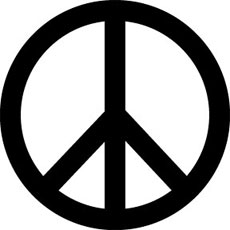☮️ Peace, Protest, and Power Chords: Rock and the Antiwar Movement

The iconic peace symbol—borrowed from British nuclear protestors, embraced by America’s youth.
The Antiwar Movement was one of the two great cultural upheavals of the 1960s—right alongside the Civil Rights Movement, which helped bring race music (what we now call R&B) into the mainstream via rock and roll (read more here).
While the Civil Rights Movement demanded justice at home, the Antiwar Movement questioned America’s role overseas—particularly in Vietnam. For many young Americans, especially teenagers and college students, it created a generational rift that felt like us vs. them: the youth vs. the establishment.
🇺🇸 A War Without a Declaration… or Direction
One reason Vietnam sparked so much protest was that it wasn’t technically a war. Congress never declared it. Instead, it was called a “police action”—a vague, open-ended conflict with unclear goals, no end in sight, and a rising death toll.
As the 1960s wore on, young people started seeing their friends get drafted, shipped overseas, and too often never return. Even those who came back brought home first-hand stories of a war that wasn’t going as advertised.
Unlike World War II, there was no sense of national unity or moral clarity. And that uncertainty, broadcast nightly on TV, stoked a growing sense of disillusionment.
🎶 Protest Through Music: From Folk to Acid Rock
At first, protest came quietly. Folk singers like Bob Dylan and Joan Baez used gentle lyrics and acoustic guitars to question authority.
But by the mid-1960s, the protests got louder—and the guitars got a whole lot fuzzier.
🎸 Country Joe and the Fish – “I Feel Like I’m Fixin’ to Die Rag”
Come on mothers throughout the land,
Pack your boys off to Vietnam.
…
You can be the first one on your block
To have your boy come home in a box.
Suddenly, protest music wasn’t subtle. It was satirical, biting, and sometimes furious. Jefferson Airplane, The Grateful Dead, and others helped usher in the era of Acid Rock, combining rebellion with experimentation—and a fair amount of LSD.
🕊️ Woodstock, Hendrix, and Turning the Anthem Inside-Out
By 1969, the movement reached its cultural crescendo at Woodstock. Flags were burned onstage. Draft cards were tossed into bonfires. And Jimi Hendrix’s rendition of “The Star-Spangled Banner” turned America’s national anthem into a screaming, distorted plea for change.
📺 Watch: Jimi Hendrix – “Star-Spangled Banner” at Woodstock (1969)
That moment didn’t just symbolize a generation’s frustrations—it amplified them.
📣 College Campuses, Draft Cards, and a Country Divided
As the war escalated, so did protests—especially on college campuses. Sit-ins, marches, and full-blown riots became more common. And rock music provided the soundtrack of dissent.
But not everyone was singing the same tune.
While rock artists rallied against the war, many in conservative America turned away, gravitating toward country music—a genre that, while related to rock, offered a more patriotic and traditional narrative.
That divide still echoes today. The cultural fault line that began in the ’60s—rock vs. country, left vs. right, coasts vs. heartland—maps closely to our modern-day Red State vs. Blue State dynamic.
✌️ Symbols of the Movement: Peace Signs and V Signs
☮ The Peace Symbol
Borrowed from a British nuclear disarmament campaign, the ☮ peace symbol took off in the U.S. during the Vietnam era. It’s so iconic, it even has its own computer code:
Unicode U+262E = ☮
✌ The V Sign
Originally a WWII “Victory” symbol, the ✌ V sign was repurposed by hippies as a hopeful call for peace. Just make sure your palm faces outward—facing inward is considered an insult in some countries (and definitely not groovy).
Unicode U+270C = ✌
📻 The Aftermath: Lasting Influence of the Antiwar Movement
As the war wound down in the 1970s, protest music gradually faded from the mainstream. But its influence never really left.
- It changed the way we see our government.
- It cemented rock and roll’s role as a vehicle for protest.
- And it created a cultural and musical divide that still shapes our political landscape today.
The Antiwar Movement wasn’t just about one war. It was about a generation daring to ask: Why are we fighting? Who are we fighting for? And what does peace really mean?
🎶 Final Thought: When the Music Fought Back
In the 1960s, music did more than entertain—it challenged, resisted, and called for change. Whether strummed on a folk guitar or blasted through a Marshall amp, protest music helped awaken a generation.
And the next time you see a peace sign—whether on a shirt, a poster, or a keyboard—you’ll know where it came from, and what it stood for.
✌️